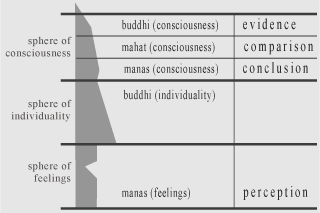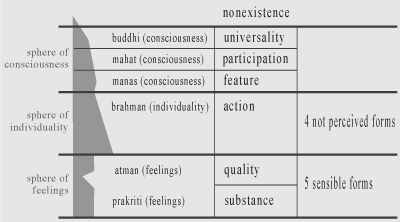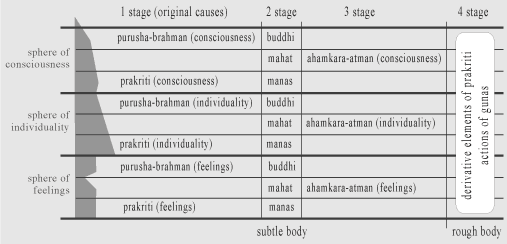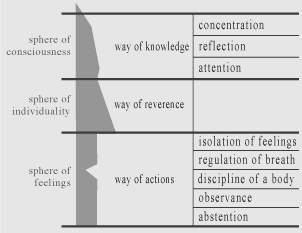-
The general source of the Indian (Hindu) philosophy are ancient texts of
Vedas, but concrete philosophical systems are comments to ancient texts, and in
essence are various opinions according to which philosophers realize the human
world.
Each philosophical system describes the world in own way, and in everyone there
is a share of true which can be considered. In aggregate philosophical systems
contain the information on different aspects of a human life, but from the point
of view of physiognomy is interesting information which corresponds with
consciousness and individuality and feelings, that corresponds to the basic
parameters of the man. Therefore from a context of those or other philosophical
systems it is enough to take necessary knowledge to correlate to physiognomy of
a face, or otherwise to tell with the physiognomic scheme of the man.
Offered descriptions of philosophical systems of ancient India consider only
some most interesting data from the point of view of physiognomy, but from the
Indian philosophy it is possible to take much more information and to compare to
physiognomy of a human face.
System of Indian (Hindu) philosophy Nyaya.
The word nyaya means "logic research".
From the point of view of philosophical system Nyaya the purpose of human
life consists in clearing the man of the real world that can be achieved by
means of true knowledge of the supreme reality, provided that the true knowledge
should be based on laws of true logic. Namely the thinking of the man should
follow four rules: perception (pratyaksha), conclusion (anumana), comparison (upamana), evidence (shabda),
that is shown in the table.
 |
The perception corresponds with physiognomic
sphere of feelings. It is connected to sense organs and it is caused by
manas-feelings, namely the perception is function according to which the
man understands the information known by means of feelings and
sensations. The conclusion corresponds with eyebrows, namely is caused by manas-consciousness in physiognomic sphere of consciousness that correlates with perception which is caused by manas-feelings in physiognomic sphere of feelings. The conclusion allows to determine attributes of phenomena which are identified by means of perception. |
The comparison corresponds with middle of forehead and namely is
caused by mahat in physiognomic sphere of consciousness. It allows to understand
names of phenomena, namely allows to connect attributes of phenomena and
words by means of which they are characterized.
The evidence corresponds with top of forehead and namely is caused by buddhi in physiognomic sphere of consciousness.
It allows to find confirmations of
knowledge by means of the supreme reality, namely allows to confirm knowledge by
means of evidences which proceed from the supreme reality.
Comprehension of the supreme reality is possible if the individual EGOISM of the
man incorporates to consciousness of the supreme EGO, namely the purpose of human life is correlation of buddhi-individuality
with buddhi-consciousness in philosophical system Nyaya.
Pay attention that concepts of knowledge of philosophical system Nyaya are a
method of a divination (method of the reference with a question to the supreme
reality), as perception - conclusion - comparison are preparatory stages of a
divination during which the man concretizes and formulates a question, and
evidence is the answer of the supreme reality to the question.
System of Indian (Hindu) philosophy Vaisheshika.
The word vaisheshika means "distinction of features".
Philosophy Vaisheshika is analogue for philosophical system of Democritus,
because both systems consider the world as connections of atoms. It is known
that Democritus was in the east, and consequently atomism of ancient Greece is
borrowed from atomism of ancient India (atomism of Hindu philosophy).
According to philosophy Vaisheshika there are seven kinds of reality, that is
shown in the table.
 |
Substance (dravya) and quality (guna)
correspond with physiognomic sphere of feelings. Action (karma) corresponds with physiognomic sphere of individuality. Feature (vishesha) corresponds with the level of eyebrows. Participation (samavaya) corresponds with middle of forehead. Universality (samanya) corresponds with top of forehead. Nonexistence (abhava) has no conformity with physiognomic levels of a human face. |
Universality is an eternal essence which is peculiar to all people
irrespective of existence or not existence of the concrete man that corresponds
to buddhi in sphere of consciousness.
Feature individualizes each separate person that corresponds to manas in sphere
of consciousness, namely feature is the factor which determines the realized
individuality of the man.
The word vishesha (feature) is a basis in the name of philosophical system Vaisheshika.
Participation means unity of general essence with individual essence of the
man that corresponds to mahat in sphere of consciousness.
Substance corresponds to prakriti in sphere of feelings and has nine forms.
Five forms are sensible and four forms are not perceived. Sensible forms are
similar to five initial elements of the Chinese philosophy or five initial
potentialities of the Greek mythology, and not perceived forms are similar to
four elements of the Greek philosophy, provided that five initial elements and four elements have other names
in philosophical system Vaisheshika.
Besides the substance has 24 qualities which correspond to atman in sphere of
feelings.
The detailed information on forms and qualities of the substance look in "Vaisheshika-Sutras".
The purpose of human life in philosophy Vaisheshika is connection of brahman-individuality
with manas-consciousness and the subsequent connection with buddhi-consciousness
by means of mahat-consciousness, that provides correlation of brahman-individuality
with buddhi-consciousness. Otherwise it is possible to tell that the purpose of
life in philosophical system Vaisheshika is comprehension of brahman-individuality
by means of understanding of features in own individuality and participation of
own consciousness in general (universal) consciousness.
System of Indian (Hindu) philosophy Samkhya.
The word samkhya means "enumeration".
According to philosophical system Samkhya there are two world original causes. The
first original cause "prakriti" is deprived consciousnesses but has activity,
and the second original cause "purusha" has consciousness but is passive. At
contact of purusha with prakriti there is the world, provided that purusha is
outside the world and prakriti forms the world. Namely the philosophical system Samkhya affirms that at the world only prakriti is present, but in essence
purusha corresponds to brahman and consequently corresponds with brahman-consciousness,
and also corresponds with brahman-individuality and brahman-feeling. Namely
purusha and prakriti are projected in three physiognomic spheres, that is shown
in the table.

As an original cause the prakriti makes the second stage in occurrence of the
world, therefore there are arising of buddhi and mahat and manas which are shown in spheres of
consciousness and individuality and feelings.
Then as a result of interaction of purusha-brahman with prakriti and as a result
of mahat actions the third stage in occurrence of the world is carried out,
namely there are arising of atman which in a context of philosophical system Samkhya has the
name ahamkara which is individuality of the man and is shown in spheres of
consciousness and individuality and feelings.
During three stages in occurrence of the world there are arising of the subtle human body (linga
sharira), then the rough physical body (sthula
sarira) is formed under influence of three gunas. Namely the combination of prakriti with buddhi
and mahat and
manas there are forming of a physical human body which consists of set of derivative elements,
and as a result actions of gunas gets quality of this or that prevailing guna.
Namely prakriti consists of three gunas: sattva (light)and rajas (energy) and tamas (darkness), and consequently as a result
in formation of derivative elements
from prakriti and formation of a rough body there is an influence of three gunas
on formation of a rough body. The
properties of consciousness and individuality and feelings get qualities of sattva
or
rajas or tamas depending on prevalence of this or that guna, and the essence of the man is in aggregate formed.
The detailed information on derivative elements of prakriti and about three
gunas look in "Samkhya-Karika".
The interrelation of a subtle body with a rough physical body attracts
attachment to a material world. To get rid of attachment it is necessary to
refuse self identification with a rough physical body, and also it is necessary to
refuse self identification with a subtle body and to return to purusha, that from
the point of view of philosophical system Samkhya is returning to original human
consciousness. Namely it is necessary to refuse attachment to a physical body
and also to the ahamkara-atman which makes a
basis of a subtle body. If to take into account that the term ahamkara-atman is
just as the soul-individuality then in essence the philosophical system Samkhya denies immortality of individual human soul but recognizes immortality
of consciousness.
-
System of Indian (Hindu) philosophy Yoga.
The word yoga means "the order of reflection".
Philosophical system Yoga are practical methods for clearing of
attachments to a material world by means of training a psycho-physiological
body. Provided that clearing means a liberation from influence of guna tamas
(darkness) and guna rajas (energy), and display of guna sattva (light).
There can be three ways of clearing which depend on features of this or that
person that is shown in the table.
 |
The way of knowledge (jnana-yoga) corresponds with
physiognomic sphere of consciousness. The way of reverence or way of beloved to a god (bhakti-yoga) corresponds with physiognomic sphere of individuality. The way of actions (karma-yoga) corresponds with physiognomic sphere of feelings. From the point of view of physiognomy if the sphere of consciousness is expressed then the yoga of knowledge is peculiar to the man. If the sphere of individuality is expressed then the yoga of reverence is peculiar to the man. If the sphere of feelings is expressed then the yoga of actions is peculiar to the man. |
Practical methods of Yoga consist in consecutive exercises which can be
compared to physiognomic levels and spheres of a human face.
Sphere of feelings:
- yama (bridling or abstention) corresponds with the chin;
- niyama (morals or observance) corresponds with the interval between chin and
lower lip;
- asana (discipline of a body) corresponds with the lower lip;
- pranayama (regulation of breath) corresponds with the upper lip;
- pratyahara (isolation of feelings) corresponds with the interval between
upper lip and nose.
Sphere of consciousness:
- dharana (attention) corresponds with eyebrows;
- dhyana (reflection or meditation) corresponds with middle of forehead;
- samadhi (concentration or merging consciousness with the object of meditation)
corresponds with top of forehead.
The sphere of individuality has no conformity with psycho-physical exercises of
Yoga, as it corresponds with methods of bhakti-yoga in which a sufficient condition
of clearing is reverence of a god, provided that bhakti-yoga assumes reverence
and familiarizing to brahman, and in essence assumes familiarizing with the
supreme consciousness as the supreme step of Yoga is the condition samadhi which
consists in an enlightenment of consciousness. Hence, the philosophical system
Yoga, as well as other philosophical systems of India, denies value of human
individuality and gives the principal value to transcendental consciousness.
Except for the listed philosophical systems within the Indian
philosophy there are other systems. The most known Vedanta and Mimamsa, and also
Buddhism which is a derivative from the Indian philosophy. The Buddhism is in
one context with philosophical systems of India, but distinctive feature of
Buddhism consists in understanding of brahman which designates
consciousness. Namely from the point of view of Buddhist philosophy there is no
immortal consciousness as if the consciousness of the man incorporates to
consciousness of brahman then human individuality disappears, and also there is
no individuality as the individual soul can not be immortal. Therefore
Buddhism denies any existence and denies any reality in limits or outside the
world.
The Buddhist philosophy is opposed to philosophical systems Vedanta and Mimamsa, as
in Vedanta the sense of human life consists in connection
with brahman that provides infinite existence during cyclic embodiments in the
material world and during cyclic returning to brahman. And the philosophical system Mimamsa affirms that human individuality is
immortal, that contradicts not only Buddhist philosophy but also contradicts all
philosophical systems of ancient India, as the individual soul
consists of atoms which dissipate in space when consciousness of the man
incorporates with brahman. Namely the statement about immortality of
individuality in a philosophical context of Mimamsa is unsupported by evidence
if to consider that genuine understanding of immortality is possible only in the
Christian philosophy.
In aggregate philosophical systems of ancient India are interesting as together
allow to understand principles of human psychology from the different points of
view, and also the Indian philosophical systems systematize structures of the
human personality that allows to correlate components of personality to
physiognomy of a human face.
More detailed analysis on philosophical systems of India I shall try to
publish in the future.
The following page represents comparison of physiognomy of a human face with philosophy of Taoism.
-